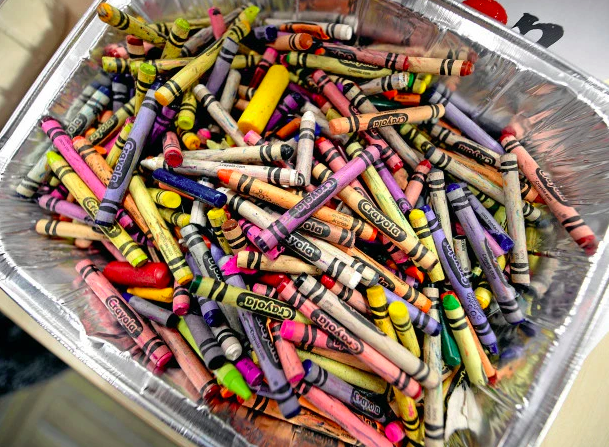The Second Life of Crayons


Take a hungry, antsy five-year-old out to the local diner and you may be in for a disaster — unless you can find a way to occupy your kid until the food arrives. Many such establishments have a solution, though: crayons. These little sticks of wax can reverse a bad dinner experience by turning that simple paper placemat into a canvas, open to your child’s imagination.
But what happens to those crayons after the meal is over?
While some restaurants will save the now-used crayons, lending them to the next family to sit down for a meal, many others simply throw them out. That’s not so great environmentally, as crayons are composed of paraffin wax, a petroleum derivative which does not break down quickly in landfills. And besides, the unused stub of a crayon is a perfectly good writing instrument — especially if you melt them down and recombine them into a smaller number of larger crayons.
Restaurants, though, don’t do that — or they didn’t, at least not until a man named Bryan Ware turned 40.
In 2011, Ware and his family went out to dinner to celebrate his milestone birthday, going to a restaurant which had crayons at the ready for his two sons. Ware noticed that the crayons were brand new and wondered what would happen to them after the meal. When he found out that the restaurant discarded the crayons, he decided to do something about it. Shortly thereafter, he and his family founded a non-profit called the Crayon Initiative.
The Crayon Initiative collects used crayons from restaurants, schools, and more, bringing them to a central location (originally the Ware’s backyard in California). There, Ware, his family, and volunteers sort through whatever they’ve acquired, organizing the used crayon bits by color. They then melt down the buckets of same-colored stubs and pour the wax into molds, forming “new” crayons in the process. (Here’s a very short video of their mold in action.) Then the crayons are boxed up — there’s no paper sleeve — and sent back out.
But they aren’t sent to restaurants. The Initiative partnered with the Children’s Hospital Association, a network of more than 200 U.S.-based children’s hospitals, to send the crayons to children in their care. Per the Initiative’s website, “a box containing 25 pounds of used crayons can yield enough raw materials to supply 125 hospitalized children with new eight-packs of crayons” — and countless smiles.
As of April 2019, per Oklahoma News 4, “the Crayon Initiative has diverted 215,000 pounds of crayons destined for landfills.” And perhaps more importantly, according to the Colorado Springs Fox affiliate, “the Crayon Initiative has collected more than 30 million crayons” and “have donated more than 226,000 new packs of crayons to children in hospitals around the country.” At eight crayons per pack, that’s nearly two million crayons in the hands of children across the country.
Bonus fact: In 1994, Crayola introduced a series of crayons which were scented — they smelled like licorice, chocolate, cherries, and other tempting treats. Unfortunately, per the New York Times, they really did smell good enough to eat — or, at least, that’s what many parents feared. Despite receiving fewer than a dozen reports of actual ingestion (and keeping in mind that the crayons are non-toxic anyway), Crayola pulled the line in the fall of 1995.
From the Archives: The Battle of the Blackest Black Versus the Pinkest Pink — not about crayons, but close enough.
